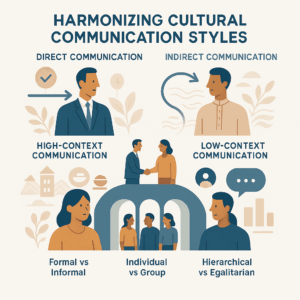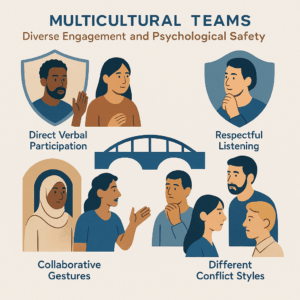
5 recommendations for talent development
5 steps on the way to relevant talent development. How we get everyone along for the ride.
How Global Leaders Navigate Diversity and Drive Innovation Through Cross-Cultural Strengths
Per has 20 years of experience within management, sales and marketing in companies. Also works as Assistant Professor at CBS, and therefore have solid experience as talent development and developer.
del
Transforming cultural differences from challenges into competitive advantages through intelligent leadership
Have you ever wondered why some leaders thrive in multicultural environments while others struggle to connect across cultural boundaries? The answer lies in cultural intelligence – a capability that’s becoming increasingly critical as organizations expand globally and teams become more diverse than ever before.
At TalentInsights, we’ve observed that leaders who master cultural intelligence don’t just manage diversity; they leverage it as a strategic advantage. They understand that different cultural perspectives aren’t obstacles to overcome but strengths to harness for innovation and performance.
But what exactly is cultural intelligence, and how do you develop it? More importantly, how do you transform cultural diversity from a management challenge into a driver of breakthrough results?
Most leadership development programs focus on cultural awareness – learning about different customs, holidays, and communication styles. While this knowledge is valuable, it’s only the starting point. Cultural intelligence goes much deeper.
Cultural intelligence is your ability to function effectively in culturally diverse settings. It’s not just knowing that Germans tend to be direct in their communication or that Japanese business culture values consensus. It’s understanding how to adapt your leadership style to work effectively with German directness and Japanese consensus-building while staying authentic to your own values and strengths.
Think about it this way: cultural awareness is like having a guidebook to a foreign country. Cultural intelligence is like being able to navigate that country, build relationships, and create value regardless of which neighborhood you find yourself in.
The leaders we work with who excel in global environments share four key capabilities. They have drive – genuine curiosity about other cultures and motivation to learn. They possess knowledge – understanding of cultural systems and how they shape behavior. They demonstrate mindfulness – awareness of their own cultural assumptions and ability to check them. And they show adaptability – flexibility to adjust their behavior while maintaining their core identity.
What’s fascinating is how these capabilities mirror the strengths-based approach we use at TalentInsights. Just as we help individuals identify and leverage their natural talents, culturally intelligent leaders learn to identify and leverage the natural strengths that different cultures bring to problem-solving and innovation.
The Innovation Advantage of Cultural Diversity
Here’s where cultural intelligence becomes a business imperative rather than just a nice-to-have skill. Research consistently shows that culturally diverse teams outperform homogeneous teams on complex problem-solving tasks. But here’s the catch – this only happens when the team has culturally intelligent leadership.

Without cultural intelligence, diversity can actually decrease performance. Team members retreat into cultural silos, communication breaks down, and different approaches to work create friction rather than synergy. But with culturally intelligent leadership, these same differences become sources of creative tension that drive breakthrough thinking.
Consider how different cultures approach problem-solving. Western cultures often emphasize linear, analytical thinking. Eastern cultures may focus more on holistic, relationship-based approaches. African cultures might prioritize community consensus and collective wisdom. Latin cultures could bring passionate, expressive communication styles.
A culturally intelligent leader doesn’t see these as competing approaches that need to be reconciled. They see them as complementary strengths that, when combined skillfully, create solutions that none of the individual approaches could achieve alone.
Developing cultural intelligence isn’t about memorizing cultural facts or trying to become a chameleon who changes completely in different cultural contexts. It’s about building specific capabilities that allow you to bridge cultural differences while leveraging your own strengths.
The first capability is cultural self-awareness. Before you can understand others, you need to understand your own cultural programming. What assumptions do you make about how work should be done? How do you define professionalism? What does good leadership look like to you? These aren’t universal truths – they’re cultural constructs that shape how you interpret and respond to different behaviors.
We often ask leaders to complete a cultural self-assessment that reveals their unconscious biases and assumptions. One executive discovered that her frustration with a team member’s “lack of initiative” was actually a cultural misunderstanding. In his culture, taking initiative without explicit permission was seen as disrespectful to authority. Once she understood this, she was able to create conditions where he could contribute his considerable talents while respecting his cultural values.
The second capability is cultural empathy – the ability to see situations from another person’s cultural perspective. This goes beyond sympathy or tolerance. It’s about genuinely understanding why someone from a different cultural background might approach a situation differently and recognizing the wisdom in their approach.
The third capability is cultural adaptation – adjusting your communication and leadership style to be more effective across cultures while maintaining your authenticity. This isn’t about becoming someone you’re not. It’s about expressing your core strengths in ways that resonate across cultural boundaries.
Leading global teams presents unique challenges that require sophisticated cultural intelligence. Time zones are the least of your worries. The real complexity lies in managing different cultural expectations around hierarchy, decision-making, conflict resolution, and performance feedback.
Take decision-making as an example. In some cultures, decisions are made quickly by senior leaders and then communicated down the hierarchy. In others, extensive consultation and consensus-building are expected before any decision is finalized. In still others, decisions emerge through informal networks and relationship-building rather than formal processes.

A culturally intelligent leader doesn’t impose one decision-making style on everyone. Instead, they create hybrid approaches that honor different cultural needs while maintaining efficiency and clarity. They might use consensus-building for strategic decisions that require buy-in across cultures, while using more directive approaches for tactical decisions that need quick implementation.
The same principle applies to feedback and performance management. Direct feedback that motivates someone from a low-context culture might be devastating to someone from a high-context culture where criticism is typically delivered indirectly and privately. Culturally intelligent leaders develop multiple feedback approaches and match them to individual cultural preferences while ensuring everyone receives the guidance they need to excel.
At TalentInsights, we believe that the most effective approach to developing cultural intelligence builds on your existing strengths rather than trying to fix your cultural “weaknesses.” If you’re naturally analytical, you can leverage that strength to systematically study and understand cultural patterns. If you’re naturally empathetic, you can use that gift to connect emotionally across cultural boundaries.
The key is understanding how your natural talents can be expressed effectively across different cultural contexts. Someone with strong strategic thinking abilities might express this differently in a culture that values long-term relationship building versus one that prizes quick decision-making. But the underlying strength remains valuable in both contexts.
This approach is particularly powerful because it maintains authenticity while building cultural effectiveness. You’re not trying to become someone else; you’re learning to be your best self in different cultural contexts.
We’ve seen remarkable transformations when leaders embrace this approach. A naturally direct communicator learned to preface difficult conversations with relationship-building in high-context cultures, making her directness more palatable while maintaining its effectiveness. A consensus-building leader learned to make faster decisions in low-context cultures while still gathering input, satisfying both cultural expectations and business needs.
One of the most important applications of cultural intelligence is creating psychological safety in diverse teams. When team members feel safe to express their cultural perspectives and work styles, they contribute more fully and creatively. When they feel they need to suppress their cultural identity to fit in, you lose access to the very diversity that could drive innovation.
Psychological safety in multicultural contexts requires more than just tolerance or acceptance. It requires active appreciation for different cultural approaches and intentional creation of space for diverse perspectives to be heard and valued.

This means establishing team norms that accommodate different cultural communication styles. Some cultures communicate directly and explicitly. Others rely on context, nonverbal cues, and indirect communication. A psychologically safe multicultural environment creates space for both styles to be effective.
It also means recognizing that conflict and disagreement may be expressed differently across cultures. What looks like disengagement might actually be respectful deference. What seems like aggressive pushback might be passionate engagement. Culturally intelligent leaders learn to read these different expressions and respond appropriately.
As organizations become increasingly global and diverse, cultural intelligence will become a core leadership competency rather than a specialized skill. The leaders who thrive in this environment will be those who can seamlessly navigate cultural differences while leveraging them for competitive advantage.
This doesn’t mean becoming culturally neutral or trying to minimize cultural differences. It means becoming culturally fluent – able to work effectively across cultures while appreciating and leveraging the unique strengths each culture brings.
The most successful global leaders of the future will be cultural bridge-builders who can create unity without uniformity, alignment without assimilation. They’ll understand that the goal isn’t to eliminate cultural differences but to orchestrate them into powerful symphonies of innovation and performance.
At TalentInsights, we’re committed to helping leaders develop this critical capability. Because in a world where cultural diversity is increasingly the norm, cultural intelligence isn’t just a leadership skill – it’s a business imperative.
The question isn’t whether you’ll need to work across cultures. The question is whether you’ll be ready to turn that cultural diversity into your organization’s greatest competitive advantage.
Ready to develop your cultural intelligence? Start by examining your own cultural assumptions and identifying opportunities to practice cultural adaptation in your current role. The investment you make in cultural intelligence today will pay dividends throughout your leadership journey.
About the Author: This article is part of TalentInsights’ 10-week series on Scandinavian leadership principles and strengths-based talent development. Learn more about our approach to developing culturally intelligent leaders at talentinsights.biz.
del

5 steps on the way to relevant talent development. How we get everyone along for the ride.

Can you afford to exclude talented organizational development? You can probably rightly claim that organizational development has existed ever since humans started organizing themselves in

Here you have a guide on how to work with talent development through leadership.